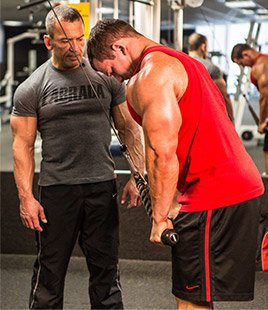I believe in squeezing out the maximum benefit from each workout session. Here are my 3 favorite training techniques to get the most from each and
every exercise, in no particular order. These strategies will make your existing
training routine more effective and diverse when it needs a boost.
Pre-exhaust training
Pre-exhaust training utilizes isolation movements to tire out a specific
muscle group before moving on to a compound movement. For example, you could
perform a chest fly before the bench press, or leg extensions before you squat. I usually carry out 100 tricep pushdowns and cable curls to warm up my arms and hit the muscles deeply.

The pre-exhaust method is one of my favorite training techniques for several
reasons. First, by significantly fatiguing the isolated muscle group, it forces
the fresh muscles to pick up the slack during the compound movement. The
fatigued muscle gets pushed beyond what it would have been able to do without
the pre-exhaust sets, and you don't have to sacrifice the full-body strength
stimulus of, say, a bench press by trying to make it into a chest isolation
exercise.
Supersets
A superset is two
exercises performed back to back with no rest between the exercises. Supersets
can increase your workout density, shorten your workout duration, spur new
growth, and deliver an incredible pump. You can pair exercises for the same
muscle group, like a triceps push-down and close-grip bench press, or pair
movements for opposing muscle groups, like biceps curls and triceps push-downs.
I love to use this technique in conjunction with the pre-exhaust technique. As
shown by the triceps push-down and close-grip bench press example above, I like
to perform an isolation exercise to pre-exhaust a muscle and then immediately
follow it with a compound move. This drives the target muscle past the point of
failure and results in a killer pump.
Rest- Pause Training
Rest-pause training
incorporates a brief rest period, or even a couple of rest periods, during a
single set. This allows you to move a heavier weight for more reps than you
could in a straight set. You allow your muscles to partially recover, but not
completely, before you hammer them with another barrage of heavy reps.
For example, if you were to perform rest-pause on a set of triceps
push-downs, you would first perform reps until you reach failure or a
predetermined number of reps, and then you would rack or hold the weight, take
an extremely brief rest period of 5-15 seconds, and rep to failure again. The
brief rest allows you to extend your set and overload the working muscle.
Rest-pause sounds simple, and it is, but I would warn you to pay close
attention to your form. Don't use such a heavy weight that you have to get
sloppy to move it. While some people go crazy with rest-pauses and use them in
multiple sets on a regular basis, I advise you limit them to a single set of
each exercise you perform. Rest-pause is an overload technique, not a
replacement for straight sets.
Incorporating these techniques into your training program will supercharge your muscle gains, building ip more muscle whilst giving you razor sharp definition.




No comments:
Post a Comment